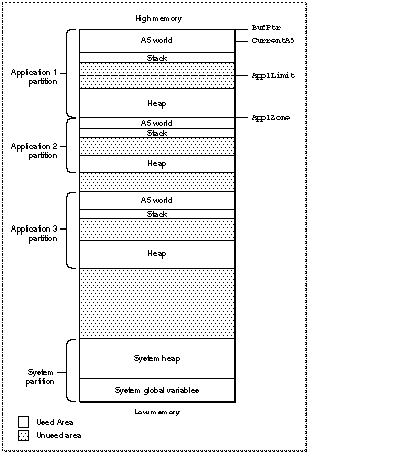
Inside Macintosh: Memory
When the Macintosh Operating System starts up, it divides the available RAM into two broad sections. It reserves for itself a zone or partition of memory known as the system partition. The system partition always begins at the lowest addressable byte of memory (memory address 0) and extends upward. The system partition contains a system heap and a set of global variables, described in the next two sections.
All memory outside the system partition is available for allocation to applications or other software components. In system software version 7.0 and later (or when MultiFinder is running in system software versions 5.0 and 6.0), the user can have multiple applications open at once. When an application is launched, the Operating System assigns it a section of memory known as its application partition. In general, an application uses only the memory contained in its own application partition.
Figure 1-1 illustrates the organization of memory when several applications are open at the same time. The system partition occupies the lowest position in memory. Application partitions occupy part of the remaining space. Note that application partitions are loaded into the top part of memory first.
Figure 1 Memory organization with several applications open

In Figure 1-1 , three applications are open, each with its own application partition. The application labeled Application 1 is the active application. (The labels on the right side of the figure are system global variables, explained in "The System Global Variables" .)
The main part of the system partition is an area of memory known as the system heap. In general, the system heap is reserved for exclusive use by the Operating System and other system software components, which load into it various items such as system resources, system code segments, and system data structures. All system buffers and queues, for example, are allocated in the system heap.
The system heap is also used for code and other resources that do not belong to specific applications, such as code resources that add features to the Operating System or that provide control of special-purpose peripheral equipment. System patches and system extensions (stored as code resources of type 'INIT' ) are loaded into the system heap during the system startup process. Hardware device drivers (stored as code resources of type 'DRVR' ) are loaded into the system heap when the driver is opened.
Most applications don't need to load anything into the system heap. In certain cases, however, you might need to load resources or code segments into the system heap. For example, if you want a vertical retrace task to continue to execute even when your application is in the background, you need to load the task and any data associated with it into the system heap. Otherwise, the Vertical Retrace Manager ignores the task when your application is in the background.
The lowest part of memory is occupied by a collection of global variables called system global variables (or low-memory system global variables ). The Operating System uses these variables to maintain different kinds of information about the operating environment. For example, the Ticks global variable contains the number of ticks (sixtieths of a second) that have elapsed since the system was most recently started up. Similar variables contain, for example, the height of the menu bar ( MBarHeight ) and pointers to the heads of various operating-system queues ( DTQueue , FSQHdr , VBLQueue , and so forth). Most low-memory global variables are of this variety: they contain information that is generally useful only to the Operating System or other system software components.
Other low-memory global variables contain information about the current application. For example, the ApplZone global variable contains the address of the first byte of the active application's partition. The ApplLimit global variable contains the address of the last byte the active application's heap can expand to include. The CurrentA5 global variable contains the address of the boundary between the active application's global variables and its application parameters. Because these global variables contain information about the active application, the Operating System changes the values of these variables whenever a context switch occurs.
In general, it is best to avoid reading or writing low-memory system global variables. Most of these variables are undocumented, and the results of changing their values can be unpredictable. Usually, when the value of a low-memory global variable is likely to be useful to applications, the system software provides a routine that you can use to read or write that value. For example, you can get the current value of the Ticks global variable by calling the TickCount function.
In rare instances, there is no routine that reads or writes the value of a documented global variable. In those cases, you might need to read or write that value directly. See the chapter "Memory Manager" in this book for instructions on reading and writing the values of low-memory global variables from a high-level language.